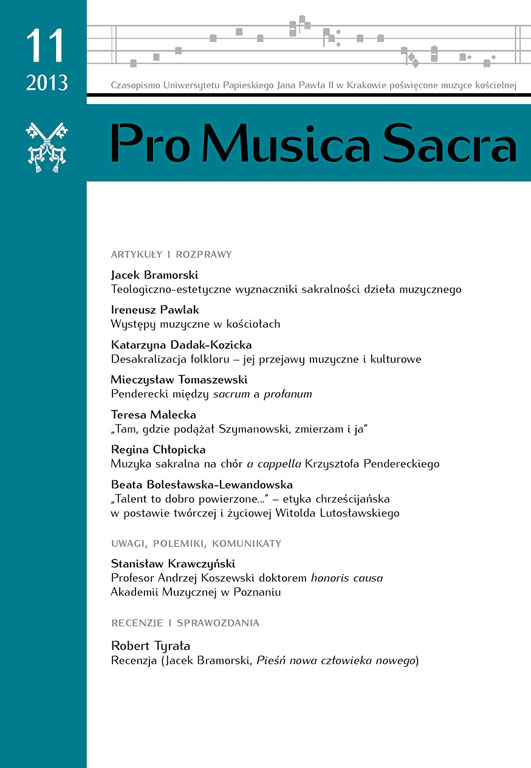„Tam, gdzie podążał Szymanowski, zmierzam i ja”
Where Szymanowski went, I went too
Author(s): Teresa MaleckaSubject(s): Music, Theology and Religion, Sociology of Culture
Published by: Wydawnictwo Naukowe Uniwersytetu Papieskiego Jana Pawła II w Krakowie
Keywords: Karol Szymanowski; Henryk Mikołaj Górecki; history of Polish music; creative power; inspirations; intertextuality;
Summary/Abstract: There has been no greater contrast of personality, biography, worldview, and lifestyle. And yet there is no end to similarities, proximities, even kinship; great was Górecki’s fascination with Szymanowski. First was the score of Beethoven’s Ninth, bought for the money earned by selling a ping-pong racket; but Górecki then spent his first savings on Chopin’s Impromptus and Szymanowski’s Mazurkas. He would recount later: “I still have these scores, and that is how my strange story begins: Beethoven’s Ninth Symphony, Chopin’s Impromptus and Szymanowski’s Mazurkas.”28 Yet apart from Górecki’s fascination with Szymanowski music and oeuvre, there is another link still. Both artists fell in love with Podhale, the Tatra Mountains and the culture of the region; so much that its main spa, Zakopane, became their second home. This went hand in hand with their fascination with the music of Podhale. The focal point for Szymanowski’s impact on Górecki brings together two masterpieces of sacred music: Stabat Mater and Symphony of Sorrowful Songs. Stabat Mater is one of Szymanowski’s few religious works; Górecki’s Sorrowful Songs are one of the many sacred works written both before and after the Symphony. Yet they are both instances of the highest artistry, of the apogee in their author’s creative achievements. Outside explicit examples of correlation between the work of Szymanowski and Górecki, there is an analogy between them of a more general nature. Taking into account the historical situation in which the two composers lived and worked, and the meanders of Polish music of the 20th centuries, the stylistic breakthrough that took place both in Szymanowski – before his Stabat Mater – and in Górecki – before his Third Symphony – was of tantamount import to establish their rank and their position in the history of Polish music.
Journal: Pro Musica Sacra
- Issue Year: 11/2013
- Issue No: 11
- Page Range: 123-134
- Page Count: 12
- Language: Polish

